ISSN ONLINE(2319-8753)PRINT(2347-6710)
ISSN ONLINE(2319-8753)PRINT(2347-6710)
Kapil A. Pakhare1, Navneet Singh2, Diwesh B. Mesharam3, Shrikant Thote4
|
| Related article at Pubmed, Scholar Google |
Visit for more related articles at International Journal of Innovative Research in Science, Engineering and Technology
This paper proposes a state of the art manufacturing procedure for customized artificial limbs and joints. amazed?? read on.The technique described in this paper tries to utilize the advanced Computer Aided Design (CAD) / Finite Element Analysis (FEA) to detect and understand the stress points in the knee, hip and the shoulder joints, and aid in the manufacture of artificial joints and limbs. This system takes input and CT scan, which is then fed into cad by means of an external reference. What is there now in the cad is a two dimensional representation of the joint. The next step is to feed the data into a solid modeling software so that a three dimensional representation of the joint is obtained. Once a true representation is obtained computer aided engineering software which uses techniques like finite element analysis gives the detailed views of the strengths and weaknesses of the different parts. The output of this would be useful in applications like surgery, manufacture of personalized artificial limbs etc. rapid prototyping is the next phase that would be adopted in the manufacture of the desired joint.
Keywords |
| CAD, FEA, Rapid Prototyping |
INTRODUCTION |
| The scientific research in the field of structural optimization has increased very substantially during the last decades, and considerable progress has been made. This development is due to the progress in reliable general analysis tools like the finite element method, methods of design sensitivity analysis, and methods of mathematical programming, and has been strongly boosted by the exponentially increasing speed and capacity. This is practically made possible by using Computer Aided Design and Analysis, which accounts for completeness and accuracy. The above applications can be utilized in determining the structural stress points in the human body Three-dimensional models are necessary for the realistic finite element analysis of joints and implants. Interfacing directly medical data to a FEA and CAD environment can improve the biomechanical analysis of joints and the design process of orthopedic implants providing very useful geometric information on different y of digital computers tissues. A direct interface between medical scanners and engineering software was used which allowed the utilization of CT scan.MRI scanner data for the generation of solid 3D models of joint structures. A system of commercially available software titles was utilized to interface data from the individual scanner format to a format usable in FEA and CAD software. The cases of the knee, hip and shoulder joint are examined. It has been possible to reconstruct the different tissue types of the joints and represent them by different volumetric entities within a FEA/CAD environment. In such a way it has been possible to represent geometrically the imaged structures in an accurate way and to assign different material properties limiting assumptions. Exporting medical imaging data to a CAD readable format has also allowed the rapid prototyping of the joint structures providing hard copies for the verification and fitting test of new implant designs. A practical and accurate system was identified for the interface of medical imaging data to an engineering environment, providing an automatic generation of joint computer models that can be used in FEA/CAD and Rapid Prototyping. Implant designs can be compared with real patient data. Implants and joint tissues can be combined, viewed, manipulated, modeled and analyzed within a single environment. The method is suggested as a better analysis tool for joints and as an improved design process for joint replacements. |
BIO-MEDICAL METHODS |
| Bio medical modeling embraces various techniques that allow the development of virtual or physical models of anatomical structures based on the information present in medical images (CT, MRI).until now, interfacing medical image data to external systems has been a particularly demanding task, requiring specific hardware, software and expertise. Medical scanners have been 'closed systems' (medical scanner and workstation form a single integrated system) that offer limited or no external access to their data. An interface system must combine: segmentation, visualization and manipulation of medical imaging data in an efficient, practical and accurate way for use in a research and clinical environment. |
| The general Bio Medical Modeling method is presented below: |
| Step 1: Image Format Recognition and Interface |
| Step 2: Image Processing and Tissue Identification |
| Step3: Three Dimensional Reconstruction |
| Step 4: Anatomical Modeling: Computer Aided Design --Computer Simulation – Finite Element analysis-- Physical Reconstruction – Medical Prototyping |
| STEP 1: Image Format Recognition And Interface |
| A wide range of formats can be recognized and utilized (Philips, GE, Hitachi, Picker, Siemens, Toshiba, Elscint). Software tools allow the recognition of almost all image data, including technical scan data. The format of the data is automatically detected and images are stored as a dataset. Interface problems of transferring data between various medical and engineering software packages and formats can be solved. Medical imaging data can be interfaced to various software environments as required. |
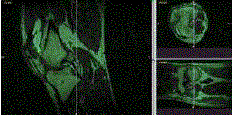 |
| STEP 2: Image Processing And Tissue Identification |
| Wide ranges of tools give us the power to enhance the image data generated by the CT OR MRI scanner. it is possible to enhance contrast; perform a fully automatic tissue selection; draw or erase tissues on each image as well as localize tissue selection; display the original scanned data along with two reconstructed views in the orthogonal planes and move images in each view in real time. |
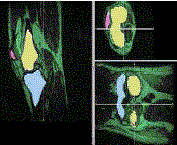 |
| STEP 3: Three Dimensional Reconstruction |
| Three-dimensional computer models of selected anatomical structures can be automatically developed within minutes utilizing data of various scanners (GE, Siemens, Phillips, etc.). The reconstruction can be viewed from any angle. Real time rotation along with the ability to apply transparency to the model is available. Advanced visualization methods also allow the combination of the model or the images with Computer Aided Design (CAD) objects. For example, an implant design can be visualized in two-dimensional cross sections along with the original CT/MRI data to verify interaction with the relevant tissue and correct positioning. |
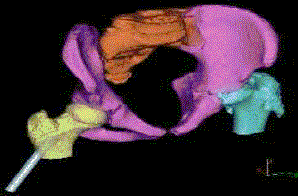 |
| STEP 4: Anatomical Modeling:- |
| CAD Modeling of Anatomical Structures |
| Computer Aided Design (CAD) is now a day used for the design of all kind of medical devices. Introducing geometrical information of anatomical structures within a CAD environment facilitates the design of any standard or custom made implants, prostheses or relevant components. Any such data had, until now, to be manually entered into the CAD environment resulting in complicated, time-consuming and impractical procedures that often resulted in computer files of enormous size requiring extremely powerful computer systems. Such methods were inefficient for use within a hospital environment or small research centers. Non-compatibility of hardware and software components has also been a very important issue. Image data once visualized segmented and three dimensionally reconstructed can be imported into a CAD environment. Solid surfaces, usable by common CAD software (STL, IGES etc.), can be generated over the 3D reconstruction. A bridge technology between scanner data and CAD systems is applied. Reference objects can be generated within the original imaging data and complex surfaces of organs can be combined with medical devices in a CAD environment. CAD objects, such as implants, can be imported within the medical data, facilitating their design. The CAD environment serves also as a tool for further modeling of the anatomical structures. Using such an interface, image-based medical design becomes a reality. |
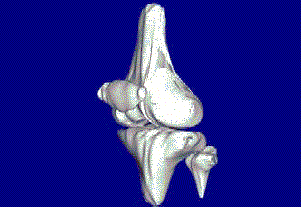 |
| Computer Simulation - Finite Element Analysis (FEA) |
| Finite Element Analysis (FEA) is widely used for the investigation of various mechanical components. In the medical field, FEA is used for the prediction of stress distribution around and within implants and the results are used in the design of medical devices. Until recently, most models have been two-dimensional and have introduced approximations regarding the presence of important tissues and their properties. In addition, finite element model development has been manual and time-consuming, producing large computer files. Medical imaging data could not be easily utilized, until now, to solve three-dimensional complex models. |
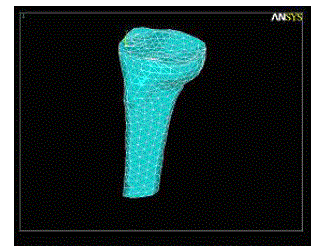 |
| Finite Element Analysis is widely used for the performance prediction of components or systems when subjected to external constraints. However, the development of a finite element model requires information on geometry, material properties, constraints and loading conditions to be known. Automatic methods are used for the development of threedimensional FEA models of body structures utilizing information of CT or MRI data. Other imaging data can also be considered. CAD data (also in IGES) can be corrected and converted into a format acceptable by various FEA software packages. The generated anatomical models incorporating tissues of interest are imported into a FEA environment. Tissues of interest are represented three dimensionally by different volumetric entities allowing the reduction of approximations regarding the presence of different properties. Methods used offer considerable reduction of computer file size, allowing the analysis of complex anatomical structures. |
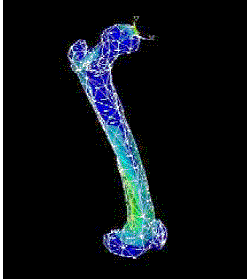 |
| Physical Reconstruction – Medical Prototyping (MRP) |
| Medical Rapid Prototyping (MRP) is the latest technique that allows us to build complex physical models of a patient's anatomy directly from images of a hospital scanner. During the last few years, the combination of medical image processing and rapid prototyping has proved to be a very important development, still to be applied on a large scale in medicine, and especially, surgery. Medical models are now used by different skill centers all around the world for a large variety of applications: 3D visualization of specific anatomy, diagnosis and communication of complex pathologies, pre-operative planning of surgical interventions, custom-made implant design, production of customized medical devices, surgical templates, teaching aids. A direct interface between the three-dimensional reconstruction and rapid prototyping allows the development of physical, real 3D, models of any anatomical structures. Such models are used for purposes of: visualization & communication, surgery rehearsal and custom implant preparation. Various RP systems can be used, but in each case, the technique is similar: |
| 1. The RP system accepts data in a format that accurately describes the surface of the component. |
| 2. The RP system software "slices" the model data into very thin sections. |
| 3. The RP system then builds the model slice upon slice. |
| Almost any complex shape can be modeled. The accuracy of RP models is usually better than 0.1 mm, which is suitable for most cases. Models can be delivered within 10 working days of receiving valid image data. |
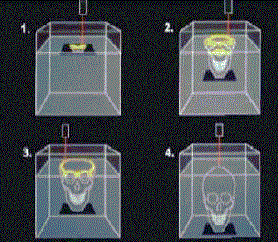 |
CONCLUSION |
| As per the data framed from this interface it is possible to achieve an artificial joint i.e. replacing the worn out one accurately by the computer aided design and finite element analysis techniques with the output obtained by technique which has shown an accuracy of 0.1mm which is rapid prototyping. This is an amazing fact because if a part is worn out in a convectional machine with the help of design of experiments it is replaced but if in a human machine if the part gets worn out it leads to miseries and unhappiness. By the application of these techniques the worn out part such as hip, knee & shoulder joints in the human machine can be replaced.This has been successfully implemented at United Kingdom and we are taking necessary steps to implement it in India. |
References |
|